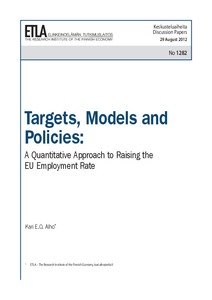Targets, models and policies: a quantitative approach to raising the EU employment rate
"The EU 2020 process has the key headline target of raising the average employment rate in the EU to 75 from the present 69 per cent. In this paper, we first derive a new result for optimal policymaking under uncertainty. It consists of two components: one of a unilateral policy reaction under...
| Main Authors: | , |
|---|---|
| Institution: | ETUI-European Trade Union Institute |
| Format: | TEXT |
| Language: | English |
| Published: |
Helsinki
2012
ETLA |
| Subjects: | |
| Online Access: | https://www.labourline.org/KENTIKA-19132520124919507029-Targets,-models-and-policies-a.htm |
| Summary: | "The EU 2020 process has the key headline target of raising the average employment rate in the EU to 75 from the present 69 per cent. In this paper, we first derive a new result for optimal policymaking under uncertainty. It consists of two components: one of a unilateral policy reaction under certainty, which is then multiplied by a scale factor, reflecting the uncertainty over the impact coefficient concerned with respect to those of the other policy variables. Based on this finding, we use a large multi-country labour market model, estimated in Bassanini and Duval (2006), to derive and discuss the various employment policy interventions and relevant labour market indicators to be monitored in the EU’s Joint Assessment Framework (JAF). As the derived optimal labour market policy entails streamlining welfare benefits and may thus jeopardise the other target of inclusion in the EU 2020 process, we then discuss and evaluate how the distributional consequences of such a policy can be mitigated through transfer and tax changes. It turns out that compensation of the losers is possible in such a way that all will gain, and employment, GDP and aggregate labour supply will all rise." |
|---|---|
| Physical Description: | 18 p. Digital |

